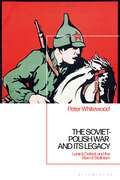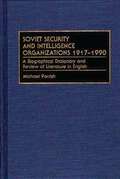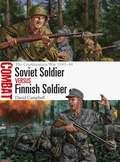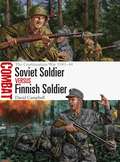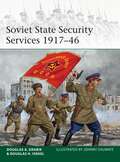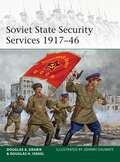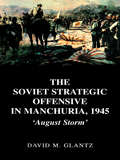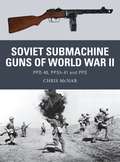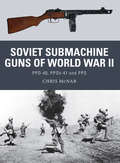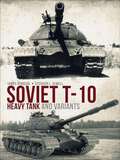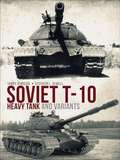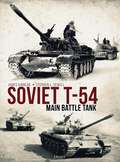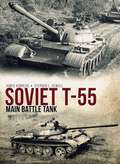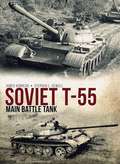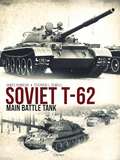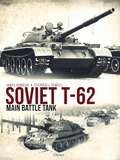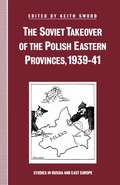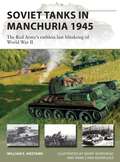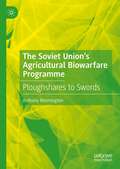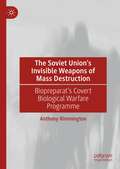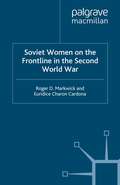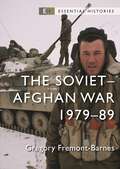- Table View
- List View
The Soviet-Polish War and its Legacy: Lenin’s Defeat and the Rise of Stalinism
by Peter WhitewoodThis detailed study traces the history of the Soviet-Polish War (1919-20), the first major international clash between the forces of communism and anti-communism, and the impact this had on Soviet Russia in the years that followed. It reflects upon how the Bolsheviks fought not only to defend the fledgling Soviet state, but also to bring the revolution to Europe. Peter Whitewood shows that while the Red Army's rapid drive to the gates of Warsaw in summer 1920 raised great hopes for world revolution, the subsequent collapse of the offensive had a more striking result. The Soviet military and political leadership drew the mistaken conclusion that they had not been defeated by the Polish Army, but by the forces of the capitalist world – Britain and France – who were perceived as having directed the war behind-the-scenes. They were taken aback by the strength of the forces of counterrevolution and convinced they had been overcome by the capitalist powers. The Soviet-Polish War and its Legacy reveals that – in the aftermath of the catastrophe at Warsaw –Lenin, Stalin and other senior Bolsheviks were convinced that another war against Poland and its capitalist backers was inevitable with this perpetual fear of war shaping the evolution of the early Soviet state. It also further encouraged the creation of a centralised and repressive one-party state and provided a powerful rationale for the breakneck industrialisation of the Soviet Union at the end of the 1920s. The Soviet leadership's central preoccupation in the 1930s was Nazi Germany; this book convincingly argues that Bolshevik perceptions of Poland and the capitalist world in the decade before were given as much significance and were ultimately crucial to the rise of Stalinism.
Soviet Security and Intelligence Organizations 1917-1990: A Biographical Dictionary and Review of Literature in English
by Michael ParrishOne of the hallmarks of the Soviet system was its heavy reliance on internal and foreign security and intelligence organizations. Not surprisingly, given the secrecy surrounding Soviet efforts in these areas, no biographical reference tools and few bibliographies have been published to date. In this context, Michael Parrish's work is a unique undertaking. In the first section to the volume, biographies are provided on some 4,000 officials in senior and mid-level positions who had served in Cheka, NKVD/RFSFR, GPU, KGB, and other organizations. Also included are officials of the Committee for State Control (formerly Ministry of State Control, and, before that, Commissariat of Workers and Peasants' Inspection). Prominent political personalities with earlier ties to security services, such as N.A. Bulganin, are listed even though such service formed only a brief part of their careers. Others listed include party officials, such as A.A. Kuznetsov, who at different times served as the Party's watchdog of security organs. Also included, because of their close association with repression and security organs, are members of Stalin's inner circle.The second part of the volume is a survey of books in English published between 1917 and 1990 which related to Soviet security and intelligence organizations. This is followed by a biographical addendum, a glossary of terms, and material showing the development of Soviet security organizations. No one concerned with current intelligence issues and the role of security organizations in Soviet life can ignore this volume.
Soviet Soldier vs Finnish Soldier: The Continuation War 1941–44 (Combat)
by David CampbellIn a bid to recapture territory conceded following the Winter War of 1939–40, Finnish forces cooperated with Nazi Germany and other Axis powers during the invasion of the Soviet Union in June 1941. Rapid Finnish progress in reoccupying lost ground in Karelia during the first few months of the invasion gave way to a more static form of warfare from October 1941. The Finns resisted German pressure to participate fully in the Axis attack on the beleaguered Soviet-held city of Leningrad, and the Continuation War came to be characterized by trench warfare and unconventional operations conducted by both sides behind the front lines. In June 1944 the stalemate was abruptly ended by a massive Soviet offensive that pushed the Finns back; the two sides clashed in a series of major battles, including the battle of Tali-Ihantala, with the Finns halting the Soviet advance before agreeing to an armistice that September. The evolving military situation in this sector of the Eastern Front meant that the soldiers of the Soviet Union and Finland fought one another in a variety of challenging settings, prompting both sides to innovate as new technologies reached the front line. In this study, the doctrine, training, equipment and organization of both sides' fighting men are assessed and compared, followed by a detailed assessment of their combat records in three key battles of the Continuation War.
Soviet Soldier vs Finnish Soldier: The Continuation War 1941–44 (Combat)
by David CampbellIn a bid to recapture territory conceded following the Winter War of 1939–40, Finnish forces cooperated with Nazi Germany and other Axis powers during the invasion of the Soviet Union in June 1941. Rapid Finnish progress in reoccupying lost ground in Karelia during the first few months of the invasion gave way to a more static form of warfare from October 1941. The Finns resisted German pressure to participate fully in the Axis attack on the beleaguered Soviet-held city of Leningrad, and the Continuation War came to be characterized by trench warfare and unconventional operations conducted by both sides behind the front lines. In June 1944 the stalemate was abruptly ended by a massive Soviet offensive that pushed the Finns back; the two sides clashed in a series of major battles, including the battle of Tali-Ihantala, with the Finns halting the Soviet advance before agreeing to an armistice that September. The evolving military situation in this sector of the Eastern Front meant that the soldiers of the Soviet Union and Finland fought one another in a variety of challenging settings, prompting both sides to innovate as new technologies reached the front line. In this study, the doctrine, training, equipment and organization of both sides' fighting men are assessed and compared, followed by a detailed assessment of their combat records in three key battles of the Continuation War.
Soviet State Security Services 1917–46 (Elite)
by Douglas A. Drabik Douglas H. IsraelThe Bolsheviks' seizure of power in Russia in late 1917 was swiftly followed by the establishment of the Cheka, the secret police of the new Soviet state. The Cheka was central to the Bolsheviks' elimination of political dissent during the Russian Civil War (1917–22). In 1922 the Soviet state-security organs became the GPU and then the OGPU (1923–34) before coalescing into the NKVD. After it played a central role in the Great Terror (1936–38), which saw the widespread repression of many different groups and the imprisonment and execution of prominent figures, the NKVD had its heyday during the Great Patriotic War (1941–45). During the conflict the organization deployed full military divisions, frontier troop units and internal security forces and ran the hated GULAG forced-labour camp system. By 1946, the power of the NKVD was so great that even Stalin saw it as a threat and it was broken up into multiple organizations, notably the MVD and the MGB – the forerunners of the KGB. In this book, the history and organization of these feared organizations are assessed, accompanied by photographs and colour artwork depicting their evolving appearance.
Soviet State Security Services 1917–46 (Elite)
by Douglas A. Drabik Douglas H. IsraelThe Bolsheviks' seizure of power in Russia in late 1917 was swiftly followed by the establishment of the Cheka, the secret police of the new Soviet state. The Cheka was central to the Bolsheviks' elimination of political dissent during the Russian Civil War (1917–22). In 1922 the Soviet state-security organs became the GPU and then the OGPU (1923–34) before coalescing into the NKVD. After it played a central role in the Great Terror (1936–38), which saw the widespread repression of many different groups and the imprisonment and execution of prominent figures, the NKVD had its heyday during the Great Patriotic War (1941–45). During the conflict the organization deployed full military divisions, frontier troop units and internal security forces and ran the hated GULAG forced-labour camp system. By 1946, the power of the NKVD was so great that even Stalin saw it as a threat and it was broken up into multiple organizations, notably the MVD and the MGB – the forerunners of the KGB. In this book, the history and organization of these feared organizations are assessed, accompanied by photographs and colour artwork depicting their evolving appearance.
The Soviet Strategic Offensive in Manchuria, 1945: 'August Storm' (Cass Series On Soviet (russian) Military Experience #Vol. 7)
by David GlantzThis critical examination of the final Soviet strategic offensive operation during World War II seeks to chip away at two generally inaccurate pictures many Westerners have of the war. Specifically, Westerners seem to think that only geography, climate, and sheer numbers negated German military skill and competency on the eastern front, a view that
The Soviet Strategic Offensive in Manchuria, 1945: 'August Storm'
by David GlantzThis critical examination of the final Soviet strategic offensive operation during World War II seeks to chip away at two generally inaccurate pictures many Westerners have of the war. Specifically, Westerners seem to think that only geography, climate, and sheer numbers negated German military skill and competency on the eastern front, a view that
Soviet Submachine Guns of World War II: PPD-40, PPSh-41 and PPS (Weapon)
by Steve Noon Chris McNab Alan GillilandThe submachine gun (SMG) came to be the embodiment of the Soviet fighting spirit during World War II. From 1943 the Red Army's preference for close-quarters combat resulted in entire infantry units being equipped with nothing but SMGs. By deploying multiple SMG-armed companies and battalions, the Red Army was able to develop ferocious firepower in urban warfare and position assaults, the soldiers keeping within the SMG's effective range of about 150m to nullify the German skills in armoured and manoeuvre warfare, artillery support and aerial bombardment. Featuring expert analysis and an array of specially commissioned full-colour artwork, this engaging study explains the history, use and development of Soviet wartime SMGs in detail. It gives particular focus to the tactical applications of these weapons in combat, and how they compared to firearms wielded by their German opponents. With numerous first-hand combat accounts, and detailed technical explanations, this book is ideal for both the general reader and the firearms enthusiast.
Soviet Submachine Guns of World War II: PPD-40, PPSh-41 and PPS (Weapon #33)
by Steve Noon Chris McNab Alan GillilandThe submachine gun (SMG) came to be the embodiment of the Soviet fighting spirit during World War II. From 1943 the Red Army's preference for close-quarters combat resulted in entire infantry units being equipped with nothing but SMGs. By deploying multiple SMG-armed companies and battalions, the Red Army was able to develop ferocious firepower in urban warfare and position assaults, the soldiers keeping within the SMG's effective range of about 150m to nullify the German skills in armoured and manoeuvre warfare, artillery support and aerial bombardment. Featuring expert analysis and an array of specially commissioned full-colour artwork, this engaging study explains the history, use and development of Soviet wartime SMGs in detail. It gives particular focus to the tactical applications of these weapons in combat, and how they compared to firearms wielded by their German opponents. With numerous first-hand combat accounts, and detailed technical explanations, this book is ideal for both the general reader and the firearms enthusiast.
Soviet T-10 Heavy Tank and Variants
by James Kinnear Stephen SewellWhen it was introduced into service in 1953, the T-10 represented a return to the “classic” Soviet heavy tank. Although considered a major threat to NATO tank forces, it also represented the end of an era. All gun heavy tanks like the T-10 would eventually be made effectively redundant by later models like the T-62 which had powerful next generation armament and new ammunition types. The tank was gradually withdrawn from service in the 1970s, though the last tanks would only leave Russian service, by decree of the President of the Russian Federation, in 1997. As such the T-10 outlived the Soviet state that had created it.Never exported outside of the Soviet Union and rarely used in combat, the T-10 has remained a mysterious tank, with many of its variants unknown in the West until very recently. This study, written from original Russian and Ukrainian primary source documents that have only recently been made available, uncovers the history of this enigmatic tank using 130 stunning contemporary and modern photographs of the T-10 as well as full colour side-view artwork.
Soviet T-10 Heavy Tank and Variants
by James Kinnear Stephen SewellWhen it was introduced into service in 1953, the T-10 represented a return to the “classic” Soviet heavy tank. Although considered a major threat to NATO tank forces, it also represented the end of an era. All gun heavy tanks like the T-10 would eventually be made effectively redundant by later models like the T-62 which had powerful next generation armament and new ammunition types. The tank was gradually withdrawn from service in the 1970s, though the last tanks would only leave Russian service, by decree of the President of the Russian Federation, in 1997. As such the T-10 outlived the Soviet state that had created it.Never exported outside of the Soviet Union and rarely used in combat, the T-10 has remained a mysterious tank, with many of its variants unknown in the West until very recently. This study, written from original Russian and Ukrainian primary source documents that have only recently been made available, uncovers the history of this enigmatic tank using 130 stunning contemporary and modern photographs of the T-10 as well as full colour side-view artwork.
The Soviet T-54 Main Battle Tank
by James Kinnear Stephen Sewell Andrey AksenovThe menacing silhouette of the T-54 tank prowling down streets of Eastern European capitals or roaring across fields in massive exercises remains one of the most enduring images of Soviet power in the early years of the Cold War. Its sleek and unmistakable shape was a warning to any nation that wanted to stand against the USSR. Yet all of this masked a flawed, outdated design, and when T-54s began to clash with the Western armoured vehicles in proxy wars in Southeast Asia and the Middle East they were found to be on the losing side of many of the battles. Containing 130 stunning contemporary and modern photographs, and written by two experts on Soviet armour, this authoritative book tells the complete story of the T-54, one of the most widely produced tanks of all time, including many previously unheard of variants.
The Soviet T-54 Main Battle Tank
by James Kinnear Stephen Sewell Andrey AksenovThe menacing silhouette of the T-54 tank prowling down streets of Eastern European capitals or roaring across fields in massive exercises remains one of the most enduring images of Soviet power in the early years of the Cold War. Its sleek and unmistakable shape was a warning to any nation that wanted to stand against the USSR. Yet all of this masked a flawed, outdated design, and when T-54s began to clash with the Western armoured vehicles in proxy wars in Southeast Asia and the Middle East they were found to be on the losing side of many of the battles. Containing 130 stunning contemporary and modern photographs, and written by two experts on Soviet armour, this authoritative book tells the complete story of the T-54, one of the most widely produced tanks of all time, including many previously unheard of variants.
Soviet T-55 Main Battle Tank
by James Kinnear Stephen SewellThe T-55 is one of the most iconic weapons created by the Soviets during the Cold War and also one of the most widely deployed weapons in history. Like its younger brother, the T-54, the T-55 enjoyed a long career in the Red Army and even into the early days of the reformed Russian Army. Under their control it saw very little combat use or deployments, but it was widely sold to other nations and participated in many of the wars and combat operations from the mid-1960s to the present. The T-55 has been employed in almost every conflict in the Middle East and Africa from its introduction into service. Even today the tank is still employed by both sides in the Syrian Civil War, and they are also in service with Kurdish forces in the struggle against ISIS in the northern part of Iraq.Containing more than 400 stunning contemporary and modern photographs, and written by two experts on Soviet armour, this authoritative book tells the complete story of the T-55, one of the most widely produced tanks of all time.
Soviet T-55 Main Battle Tank
by James Kinnear Stephen SewellThe T-55 is one of the most iconic weapons created by the Soviets during the Cold War and also one of the most widely deployed weapons in history. Like its younger brother, the T-54, the T-55 enjoyed a long career in the Red Army and even into the early days of the reformed Russian Army. Under their control it saw very little combat use or deployments, but it was widely sold to other nations and participated in many of the wars and combat operations from the mid-1960s to the present. The T-55 has been employed in almost every conflict in the Middle East and Africa from its introduction into service. Even today the tank is still employed by both sides in the Syrian Civil War, and they are also in service with Kurdish forces in the struggle against ISIS in the northern part of Iraq. Containing more than 400 stunning contemporary and modern photographs, and written by two experts on Soviet armour, this authoritative book tells the complete story of the T-55, one of the most widely produced tanks of all time.
Soviet T-62 Main Battle Tank
by James Kinnear Stephen SewellThe T-62 is one of the most widespread tanks used by the Soviets during the Cold War. Developed from the T-55, the T-62 enjoyed a long career in the Red Army and even into the early days of the reformed Russian Army. It was the principal tank used by Soviet forces in the Soviet-Afghan War, and went on to see service with Russian forces in Chechnya and South Ossetia. It has also been employed in almost every conflict in the Middle East and Africa from its introduction into service. It remains in service with many countries throughout the world and has seen a great deal of use in the Syrian Civil War. Containing more than 400 stunning contemporary and modern photographs, and written by two experts on Soviet armour, this authoritative book tells the complete story of the T-62.
Soviet T-62 Main Battle Tank
by James Kinnear Stephen SewellThe T-62 is one of the most widespread tanks used by the Soviets during the Cold War. Developed from the T-55, the T-62 enjoyed a long career in the Red Army and even into the early days of the reformed Russian Army. It was the principal tank used by Soviet forces in the Soviet-Afghan War, and went on to see service with Russian forces in Chechnya and South Ossetia. It has also been employed in almost every conflict in the Middle East and Africa from its introduction into service. It remains in service with many countries throughout the world and has seen a great deal of use in the Syrian Civil War. Containing more than 400 stunning contemporary and modern photographs, and written by two experts on Soviet armour, this authoritative book tells the complete story of the T-62.
The Soviet Takeover of the Polish Eastern Provinces, 1939–41 (Studies In Russia And East Europe Ser.)
by Keith SwordSoviet Tanks in Manchuria 1945: The Red Army's ruthless last blitzkrieg of World War II (New Vanguard)
by William E. HiestandA new illustrated study of the devastating, but little-known, Soviet armored blitzkrieg against the Japanese in the last weeks of World War II, and how it influenced Soviet tank doctrine as the Cold War dawned.Although long overshadowed in the West by the dropping of the atomic bombs on Hiroshima and Nagasaki, the USSR's lightning strike into Manchuria in August 1945 was one of the most successful and unique campaigns of the era. Soviet forces, led by over 5,500 tanks and self-propelled guns, attacked across huge distances and deserts, marshes, and mountains to smash Japan's million-strong Kwantung Army in a matter of days.Japanese forces were short of training and equipment, but nevertheless fought fiercely, inflicting 32,000 casualties on the Soviets. Red Army operations were characterized by surprise, speed, and deep penetrations by tank-heavy forces born of the brutal lessons they had learned during years fighting the Wehrmacht. Lessons from the campaign directly shaped Soviet Cold War force structure and planning for mechanized operations against the West.Illustrated with contemporary artwork and rare photos from one of the best collections of Soviet military photos in the West, this fascinating book explains exactly how the last blitzkrieg of World War II was planned, fought, and won, and how it influenced the Red Army's plans for tank warfare against NATO in Europe.
Soviet Tanks in Manchuria 1945: The Red Army's ruthless last blitzkrieg of World War II (New Vanguard #316)
by William E. HiestandA new illustrated study of the devastating, but little-known, Soviet armored blitzkrieg against the Japanese in the last weeks of World War II, and how it influenced Soviet tank doctrine as the Cold War dawned.Although long overshadowed in the West by the dropping of the atomic bombs on Hiroshima and Nagasaki, the USSR's lightning strike into Manchuria in August 1945 was one of the most successful and unique campaigns of the era. Soviet forces, led by over 5,500 tanks and self-propelled guns, attacked across huge distances and deserts, marshes, and mountains to smash Japan's million-strong Kwantung Army in a matter of days.Japanese forces were short of training and equipment, but nevertheless fought fiercely, inflicting 32,000 casualties on the Soviets. Red Army operations were characterized by surprise, speed, and deep penetrations by tank-heavy forces born of the brutal lessons they had learned during years fighting the Wehrmacht. Lessons from the campaign directly shaped Soviet Cold War force structure and planning for mechanized operations against the West.Illustrated with contemporary artwork and rare photos from one of the best collections of Soviet military photos in the West, this fascinating book explains exactly how the last blitzkrieg of World War II was planned, fought, and won, and how it influenced the Red Army's plans for tank warfare against NATO in Europe.
The Soviet Union’s Agricultural Biowarfare Programme: Ploughshares to Swords
by Anthony RimmingtonThis book focuses upon the secret agricultural biological warfare programme codenamed Ekologiya – which was pursued by the Soviet Union from 1958 through to the collapse of the USSR in 1991. It was the largest offensive agricultural biowarfare project the world has ever seen and Soviet anti-crop and anti-livestock weapons had the capability to inflict enormous damage on Western agriculture. Beginning in the early 1970s, there was a new focus within the Soviet agricultural biowarfare programme on molecular biology and the development of genetically modified agents. A key characteristic of the Ekologiya project was the creation of mobilization production facilities. These ostensibly civil manufacturing plants incorporated capacity for production of biowarfare agents in wartime emergency. During the 1990s-2000s, the counter-proliferation efforts undertaken by the US and UK played a major role in preventing the transfer of Ekologiya scientists, technologies and pathogens to Iran and other countries of potential proliferation concern.Anthony Rimmington is a former Senior Research Fellow at Birmingham University’s Centre for Russian, European and Eurasian Studies, UK. He has published widely on the civil life sciences sector in the post-Soviet states and on the Soviet Union’s offensive biological warfare programme, including Stalin’s Secret Weapon: The Origins of Soviet Biological Warfare.
The Soviet Union’s Invisible Weapons of Mass Destruction: Biopreparat's Covert Biological Warfare Programme
by Anthony RimmingtonThis book focuses on Biopreparat, the Soviet agency created in 1974, which spearheaded the largest and most sophisticated biological warfare programme the world has ever seen. At its height, Biopreparat employed more than 30,000 personnel and incorporated an enormous network embracing military-focused research institutes, design centres, biowarfare pilot facilities and dual-use production plants. The secret network pursued major offensive R&D programmes, which sought to use genetic engineering techniques to create microbial strains resistant to antibiotics and with wholly new and unexpected pathogenic properties. During the mid-1980s, Biopreparat increased in size and political importance and also emerged as a major civil biopharmaceutical player in the USSR. In the wake of the collapse of the Soviet Union in 1991, an acute struggle for control of Biopreparat’s most valuable assets took place and the network was eventually broken-up and control of its facilities transferred to a myriad of state agencies and private companies.
Soviet Women on the Frontline in the Second World War
by R. Markwick E. Charon Cardona Euridice Charon CardonaThis is the first comprehensive study in English of Soviet women who fought against the genocidal, misogynist, Nazi enemy on the Eastern Front during the Second World War. Drawing on a vast array of original archival, memoir, and published sources, this book captures the everyday experiences of Soviet women fighting, living and dying on the front.
The Soviet–Afghan War: 1979–89 (Essential Histories)
by Gregory Fremont-BarnesA fully illustrated overview of the USSR's bloody conflict in Afghanistan and its long legacy.The Soviet invasion of its neighbour Afghanistan in December 1979 sparked a nine-year conflict until Soviet forces withdrew in 1988–89, dooming the communist Afghanistan government to defeat at the hands of the mujahideen, the Afghan popular resistance backed by the USA and other powers. Gregory Fremont-Barnes reveals how the Soviet invasion had enormous implications on the global stage; it prompted the US Senate to refuse to ratify the hard-won SALT II arms-limitation treaty, and the USA and 64 other countries boycotted the 1980 Moscow Summer Olympics. For Afghanistan, the invasion served to prolong the interminable civil war that pitted central government against the regions and faction against faction. Updated and revised for the new edition, with full-colour maps and new images throughout, this succinct account explains the origins, events and consequences of the Soviet intervention in Afghanistan, shedding new light on the more recent history – and prospects – of that troubled country.
